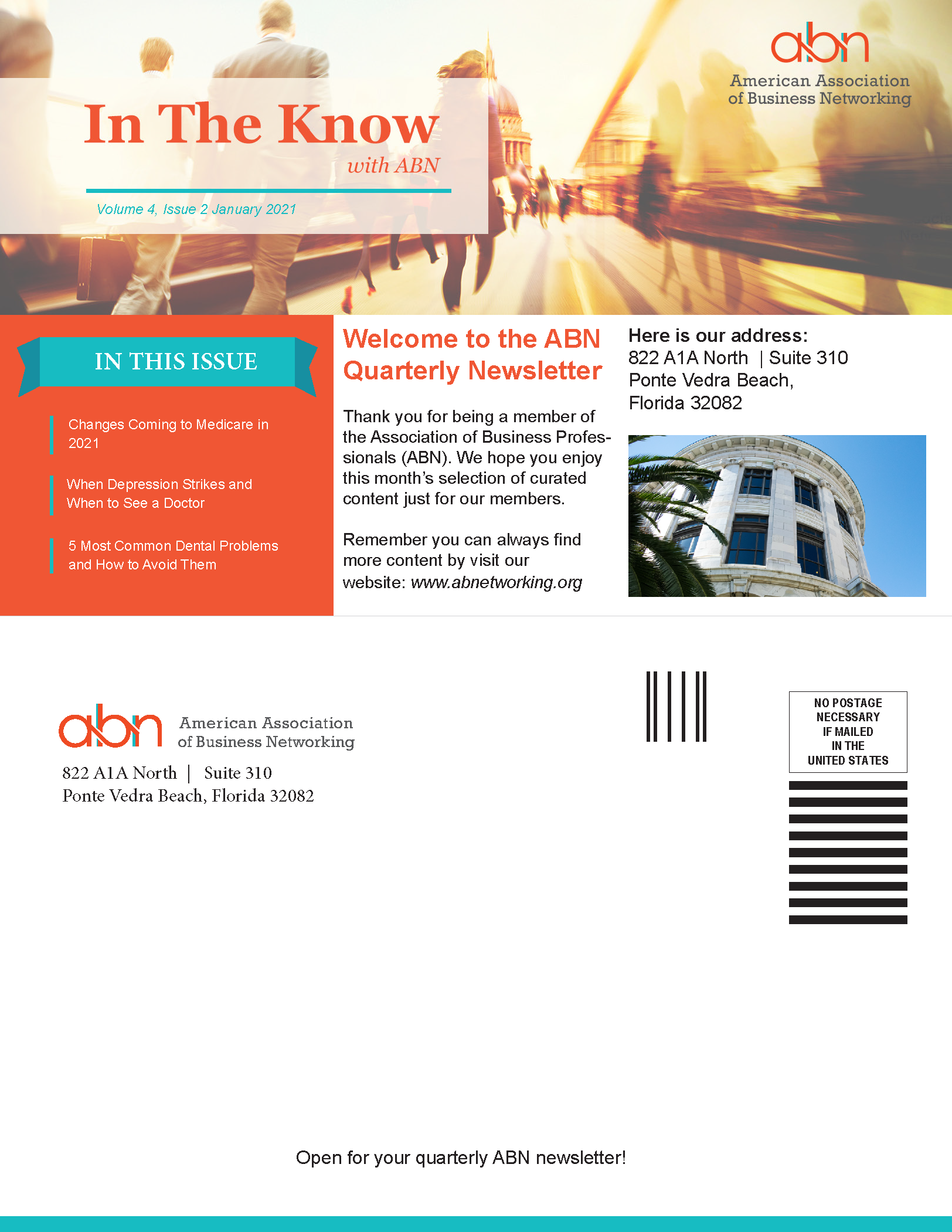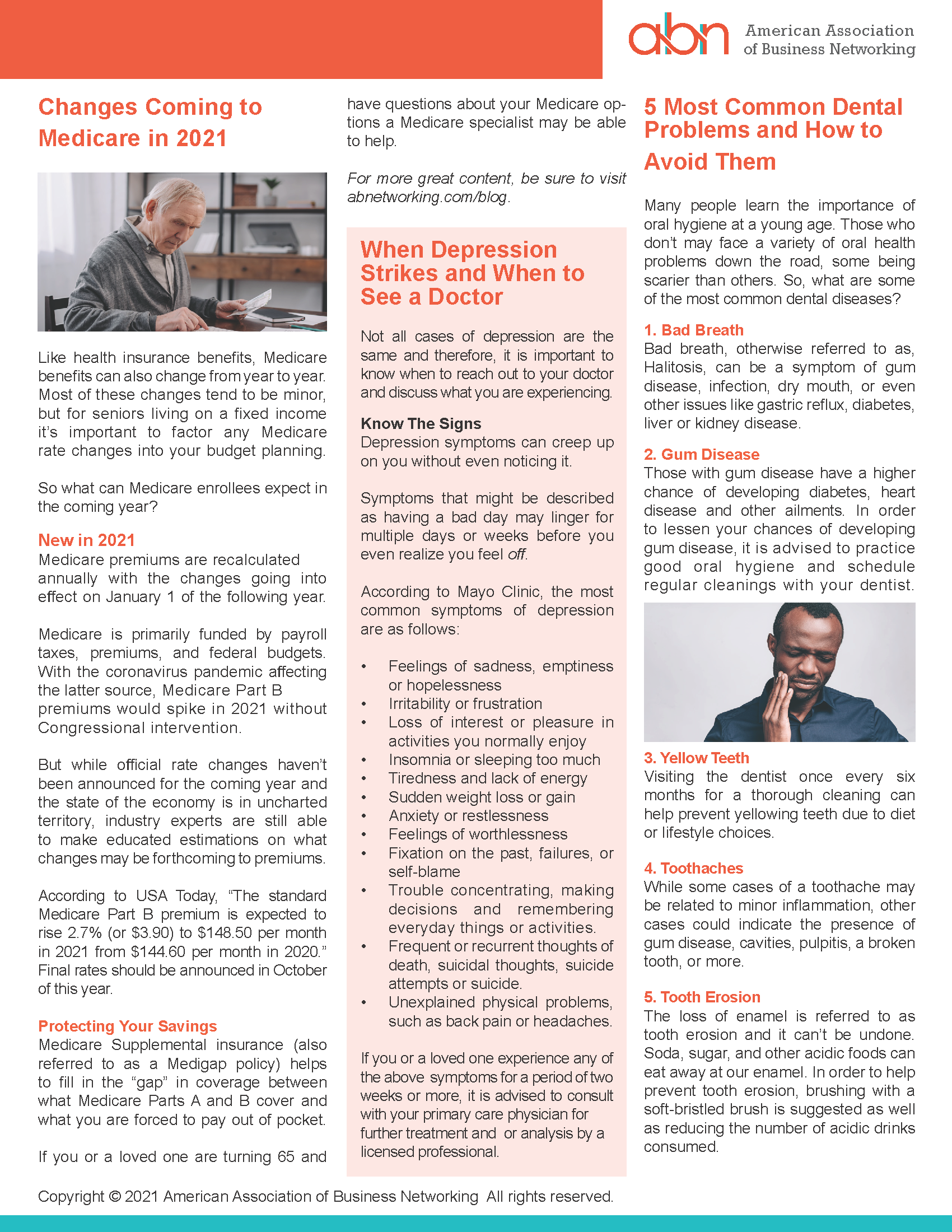ABN Newsletter Volume 4, Issue 2 January 2021



Over the last year we’ve spent a lot of time focusing on staying healthy. We’ve washed our hands to the tune of happy birthday, worn face masks in public, and stayed home instead of going out. But when was the last time we focused on our oral health? Science has shown that problems that begin in our mouths can have an impact on the rest of our bodies.
But aside from daily flossing and brushing, taking care of our teeth and gums can be expensive. Dental insurance can help you cover the cost of keeping your teeth and gums as healthy as possible.
So, what else can dental insurance help you cover?
Dental pain is often a double-edged sword. There’s the physical pain – and for those without insurance – the pain of a hollowed-out wallet.
If you find yourself experiencing tooth pain, there’s a chance it is the result of something left unattended for too long and now requires major restorative work.
Most dental insurance plans offer deep savings on major restorative dental work and cover all or most preventative care which can help you avoid dental emergencies in the future.
The American Dental Association recommends that you visit a dentist at least once a year for an exam and cleaning.
You may not always know what dangers could be just around the corner for you and your pearly whites—but a dentist can. Minor issues can lead to bigger and more costly ones down the road.
But the good news is that costly and painful dental problems can often be avoided with regular visits to a dentist and maintaining an oral hygiene routine at home.
According to the Pennsylvania Dental Association, roughly 4 million people in the U.S. wear braces. But perfectly straight teeth can come at a hefty price.
The cost of dental braces can range anywhere between $3,000 and $10,000 (not including any other orthodontia services that may be required to help you achieve perfectly straight teeth).
And while not all dental insurance plans cover orthodontia, the ones that do can save you thousands, making you or your children’s path to a great smile a lot less painful.
Dental insurance can help you and your family maintain your smiles for years to come. Tackle dental emergencies knowing you’re covered, address concerns before they become problems, and prevent future issues while saving on your out-of-pocket costs.

The holidays are going to look a lot different this year due to COVID-19.
Every year millions of Americans pile into each other’s homes to celebrate the season with food, family, and football. That urge has never been stronger than this year. With millions of people working from home and many states enacting safer-at-home measures, Americans are feeling the financial, physical, and mental health effects of living in a coronavirus-infected world.
But in addition to practicing social distancing, there are several things you can do to remain healthy while minimizing the risk of contracting and spreading COVID-19 (or any illness).
According to the CDC, “travel increases the chance of getting and spreading the virus that causes COVID-19. Staying home is the best way to protect yourself and others.” And as COVID-19 cases continue to spike throughout the country, many experts are urging Americans to avoid holiday travel.
Many states are imposing new limitations on gathering sizes, extending mask mandates, and even issuing mandatory quarantine periods (or negative COVID-19 test) for people traveling from other states. If you or your loved ones are considering traveling internationally during the holidays, please be sure to make sure the country you are traveling to is granting entry to travelers from your point of origin.
Technology can help us feel connected to our loved ones when we can’t be there in person—something that has proven to be essential for so many people this year.
Video calls have skyrocketed in popularity this year professionally and personally. Zoom did its part to bring people together safely by lifting their 40-minute limit on free meetings for Thanksgiving Day this year.
Consider using video chat services or avoiding in-person contact altogether through the holidays if you or a family member are at a high risk of contracting the COVID-19 virus.
You may want to consider skipping the check-out lines this year and put your health first by shopping for gifts online.
Traditional brick and mortar stores will still be dangerous areas despite heightened cleaning measures. The CDC has listed “Going shopping in crowded stores just before, on, or after Thanksgiving” as a higher-risk activity.
Due to the anticipated surge of online shoppers this season, many big-name retailers have announced changes to their traditional holiday sales such as online-only sales, online pick-up options, and more.
Studies continue to affirm the effectiveness of wearing a mask in helping to prevent the spread of COVID-19. And both local and federal government branches have cited the importance of wearing a mask when around other people who do not live in your home. So if you find yourself going out in public or spending time with friends and family, consider wearing a mask to protect yourself and others.
Modern medicine has yet to fully discover the long-term effects of COVID-19 but there are many health conditions scientists can already link to the virus.
According to the Mayo Clinic, “COVID-19 symptoms can sometimes persist for months. The virus can damage the lungs, heart and brain, which increases the risk of long-term health problems.”
Having health insurance coverage for you and your family can help cover the cost of both major and preventative medical care – and now is the best time to get coverage. The annual individual health Open Enrollment period began on November 1 and runs through December 15.
This is the only time of year to enroll in ACA-compliant health coverage unless you experience a Qualifying Life Event.

According to the Council for Disability Awareness, it is estimated that one out of every four Americans will find themselves diagnosed with a disability prior to retiring at the age of 65. Additional studies show that less than half of individuals and families have enough money saved to sustain their living expenses for even one month before feeling the financial strain— illustrating that a long-term disability diagnosis can not just be devastating for the individual but also financially devastating for their entire family.
In short, no one plans to become disabled. And yet, it can happen to anyone at any time and the chances of it happening only increase with age, lifestyle choices, and even the type of work we do on a daily basis.
But while the majority of people may imagine someone who struggles with a long-term disability as wheelchair bound, the fact of the matter is that long-term disabilities can manifest in a host of different ways— some visible, some not.
Below are the top five long-term disability diagnosis types by category according to our own research and the CDA’s 2013 Long-Term Disability Claims Review:
According to the CDA’s 2013 Long-Term Disability Claims Review, nearly one-third of all long-term disability claims are due to musculoskeletal and connective tissue disorders. These are best described as issues related to neck and joint pain as well as back and neck issues; muscle and tendon problems; foot, ankle and hand disorders as well.
More specifically, the following are among the most commonly diagnosed musculoskeletal and connective tissue disorders and conditions:
Most nervous system disorders are common and can be helped or managed with treatments such as physical therapy and/or medication. Nevertheless, with some being generative, working full-time or even part-time can prove extremely difficult.
Below are a few common nervous system related disorders:
According to the American College of Cardiology (ACC), it is estimated that an average of one person dies every 40 seconds in America due to cardiovascular disease. But for those individuals who experience cardiovascular issues and require surgeries and rehabilitation services, the time spent recovering can have a serious impact on their livelihood— limiting them from earning a paycheck as well as increased difficulties managing day-to-day activities.
Studies estimate that 41% of men and 38% of women will develop some form of cancer within their lifetime. And while hereditary factors and lifestyle choices can play a part in determining one’s risk factor, there is no fool-proof way of determining if or when you will be diagnosed with cancer.
If a cancer diagnosis or tumor does occur treatments such as chemotherapy, radiation, and surgeries can leave your body sick, exhausted, and bedridden among other things. During this time, it may be difficult or impossible for you to keep up with your job duties.
Depression and anxiety are among the most common mental disorders that can affect one’s ability to work. Though the systems may not appear physical (though they can), mental disorders are nothing to be brushed off. If you experience lingering or worsening symptoms of depression or other mental disorders for a period of two weeks or more, talking to your doctor may prove helpful.
Most disorders can improve over time with the proper medical attention but leaving them untreated can lead to worsening symptoms that can have an effect on every facet of your life and limit you from living your best life.
Just because no one can predict the future, doesn’t mean you shouldn’t still plan for it.

When the air gets cooler and the trees start to lose their leaves, the holiday season is never far behind. It is a great time for family, friends, good food, vacations, and enjoying each other’s company. But what happens when you can’t seem to find your holiday spirit?
If your spirit is lacking this season, it could be a sign of something much more important.
Depression doesn’t strike when it is most convenient for you, sometimes there is a reason for it and sometimes there is not. In fact, it is not at all uncommon to develop depression symptoms during the holiday season.
But not all cases of depression are the same and therefore, it is important to know when to reach out to your doctor and discuss what you are experiencing.
How do you know when you are displaying symptoms of depression?
One of the largest misconceptions regarding depression is that people who suffer from it are sad all the time and in some cases, may want to commit suicide. What many fail to realize is that depression is much more than that.
Depression is different in that it can creep up on you without you even noticing it. Symptoms that might be described as being in relation to a bad day may continue to linger for multiple days or weeks before you even realize feeling off.
According to Mayo Clinic, the most common symptoms of depression are as follows:
If you should experience any of these symptoms, or a combination of them for a period of two weeks or more, it is advised to consult with your primary care physician.

According to American author William Arthur Ward, “A warm smile is the universal language of kindness.” Smiling is something we do instinctively as infants and something we carry with us all throughout our lives. Unfortunately for some, their smiles may not prove to be as warm and welcoming as they would hope. Problems such as gum disease, yellowed teeth, and chronic bad breath can have a negative impact when meeting new people and could be a sign of a deeper issue due to the close link between oral and overall health.
Many people learn the importance of oral hygiene at a young age. Those who don’t may face a variety of oral health problems down the road, some being scarier than others. So, what are some of the most common dental diseases?
While some cases of bad breath can be the result of eating foods like onions, garlic, or hard-boiled eggs, other cases may prove to be more serious. Bad breath, otherwise referred to as, Halitosis, may be something that even a good solid brushing won’t be able to fix. Halitosis can be a symptom of larger problems such as gum disease, infection, dry mouth, or even other seemingly unrelated issues like gastric reflux, diabetes, liver or kidney disease. In some instances, Halitosis may even require a trip to your doctor.
According to the Mayo Clinic, there are over 3 million cases of gum disease each year. And while gum disease, otherwise known as Periodontitis, may be common, that doesn’t make it any less serious. In fact, those with gum disease have a higher chance of developing diabetes, osteoporosis, heart disease and other ailments. In order to lessen your chances of developing gum disease, it is advised to practice good oral hygiene and schedule regular cleanings with your dentist, who may decide whether more preventative action is needed.
While not exactly a disease, yellow teeth can be a sign of poor oral hygiene and can, in some cases, indicate other dental issues that may be lurking just beneath the surface. Visiting the dentist once every six months for a thorough cleaning can help prevent yellowing teeth due to diet or lifestyle choices. In some severe cases, veneers may be recommended.
A toothache should never be ignored. While some cases of a toothache may be related to minor inflammation, other cases could indicate the presence of gum disease, cavities, pulpitis, a broken tooth, or more. When confronted with a persistent toothache, the best course of action is to have a dentist find the underlying cause.
There are few substances within the human body that are stronger than our enamel. This is why everyone from our dentists to television commercials are constantly urging us to protect it — because once our enamel is gone, it cannot be brought back. The loss of enamel is referred to as tooth erosion. Soda, sugar, and some acidic foods can eat away at our enamel. In order to combat the chances of experiencing tooth erosion, brushing with a soft-bristled brush is suggested as well as reducing the number of acidic drinks consumed.
When was the last time you visited the dentist? Could you be at risk of developing one, or even all, of these potentially costly dental problems?

Like health insurance benefits, Medicare benefits can also change from year to year. Most of these changes tend to be minor, but for seniors who may be living on a fixed income it’s important to factor any Medicare rate changes into your budget planning.
So what can Medicare enrollees expect in the coming year?
Medicare premiums are recalculated annually with the changes going into effect on January 1 of the following year.
Medicare is primarily funded by payroll taxes, premiums, and federal budgets. With the coronavirus pandemic affecting the latter source, Medicare Part B premiums would spike in 2021 without Congressional intervention. Protecting enrollees from rising Medicare premiums is an issue that receives bipartisan support and is expected to be addressed in the next coronavirus relief package, or later this fall.
According to CNBC, “The idea is to protect Medicare’s 62.5 million beneficiaries — the majority of whom are age 65 or older — from a spike in Part B premiums due in part to reduced money flowing into the program from pandemic-related economic troubles.”
But while official rate changes haven’t been announced for the coming year and the state of the economy is in uncharted territory, industry experts are still able to make educated estimations on what changes may be forthcoming.
According to USA Today, “The standard Medicare Part B premium is expected to rise 2.7% (or $3.90) to $148.50 per month in 2021 from $144.60 per month in 2020.” Final rates should be announced in October of this year.
Medicare Supplemental insurance (also referred to as a Medigap policy) helps to fill in the “gap” in coverage between what Medicare Parts A and B cover and what you are forced to pay out of pocket.
If you or a loved one are turning 65 and have questions about your Medicare options a Medicare specialist may be able to help.

When contemplating insurance needs, most people take great care in making sure they have a suitable life insurance policy and medical coverage. You might not think you need something like Accidental Death and Dismemberment coverage. As an attorney, your profession doesn’t often put you in harm’s way — you’re not building high rises or doing a physical job that comes with those inherent risks. But the truth is, accidents still happen to people who aren’t taking great daily risks — and here’s why AD&D coverage should be considered in addition to your other insurance policies.
Life insurance still pays in the event of an accidental death, so you may wonder why you would need both types of coverage. In the case of an accident resulting in your death, an AD&D policy would provide extra coverage beyond what your life insurance policy covers. AD&D policies are typically less expensive, too, so they are a more cost effective way to increase your coverage in the event of an accident.
Another thing to consider when adding to your insurance coverage is your family’s likely need at the time — an accidental death often leaves families unprepared for the sudden loss of income and financial strain. By definition, accidental deaths are not something you can prepare for and, even with excellent life insurance, this is an event that can have long-lasting financial repercussions on the family as a whole.
An additional reason you should consider an AD&D policy lies in the Dismemberment feature of the coverage. Your life insurance policy does not cover permanent injuries and your medical coverage will only aid you in paying bills associated with treating those injuries, not loss of work or any other lifestyle impairment you might suffer from a permanent disability. That is where the Dismemberment coverage can help.

Did you know that one in four Americans over 65 have no teeth? That being said, a healthy smile can be an impressive asset! Your teeth vary in shape and size depending on where they are in your mouth. These differences allow them to do many different jobs. They help us talk, pronounce different sounds clearly and give our faces their shape! Because they are so important, it makes sense to give your teeth the best care possible. For most of us, thorough daily oral hygiene lays the foundation for a healthy smile. Just a simple routine of brushing and flossing, in addition to regular dental checkups, can be enough in most cases to help prevent tooth decay, gum disease, and bad breath.
Follow these tips to hold onto your smile!
We have heard this our whole lives, but not many of us do it. If you floss before brushing, you remove food that is trapped in tight spots – which are major “bacteria growth” zones. Place your brush at a slight angle toward the gums when brushing along the gum line. Use a gentle touch—it doesn’t take much pressure to remove the plaque from your teeth, and a vigorous scrubbing could irritate your gums. Concentrate on cleaning all the surfaces of the teeth. To help prevent tooth decay, use a fluoride-containing toothpaste.
Many people think that having a high level of sugar in your diet is the most common reason for tooth decay. This is not true – it is how often you have sugar in your diet, not the amount. It takes up to an hour for your mouth to cancel out the acid caused by eating and drinking sugar. Give your teeth a cleanse by munching on crunchy vegetables or fruits at the end of a meal, this serves as a type of mini tooth-brushing session. The hard flesh acts as a cleanser and the chewing motion stimulates saliva production. Replace your afternoon soda with tea – tea leaves contain the tooth protector fluoride. Studies show that green tea drinkers have a lower incidence of advanced gum disease. As an added bonus, researchers believe that the catechin in green tea is more effective than mints at combating bad breath.
Vitamin C, Calcium, Vitamin D and Omega-3 are vital for maintaining and repairing gum tissue. Everything from tooth sensitivity to receding gums can often be attributed to Vitamin C deficiency. Calcium is crucial for strong teeth and healthy bones. Vitamin D helps maximize calcium absorption. Omega-3 or fish oil supplements can help gum tissue heal.
Medicine, both prescription and over-the-counter, can often cause decreased saliva production. This is dangerous because saliva serves as a protective barrier against gum and tooth decay. When on medicine, be sure to take frequent sips of water or chew sugar-free gum to help relieve dry mouth. If this doesn’t do the trick, consult your dentist!
Only a dentist can truly assess the health of your gums. It is important to keep up with cleanings and regular six-month checkups. Gum disease is a serious infection that can lead to tooth loss and compromised health if left untreated. These are some of the warning signs that should prompt you to see a dentist: